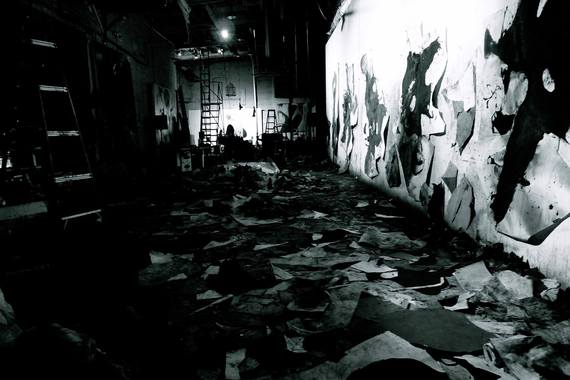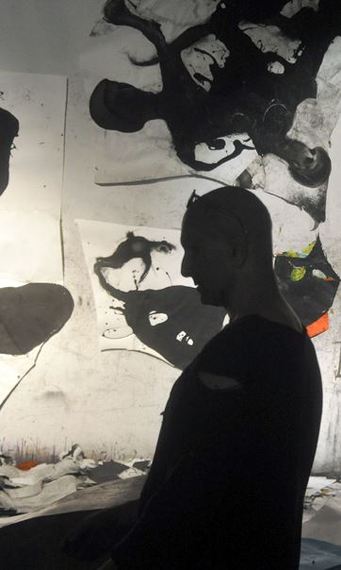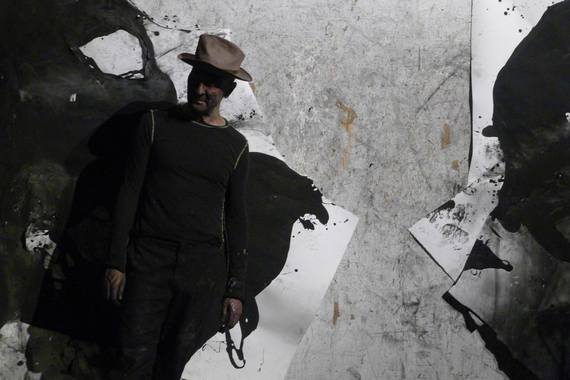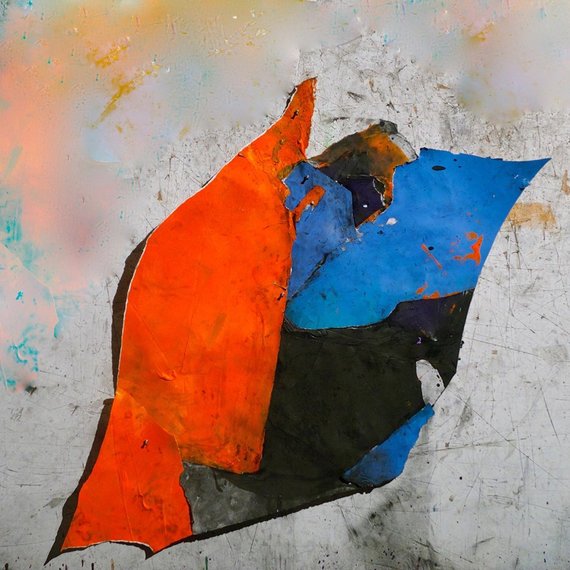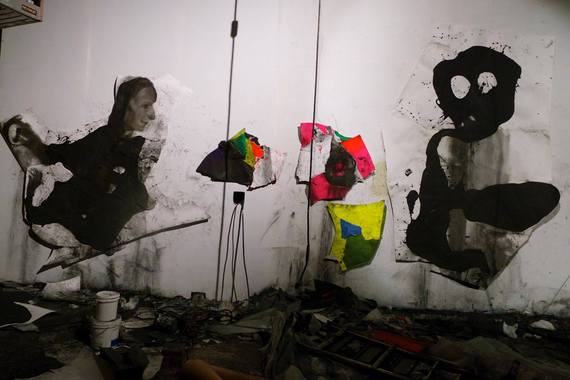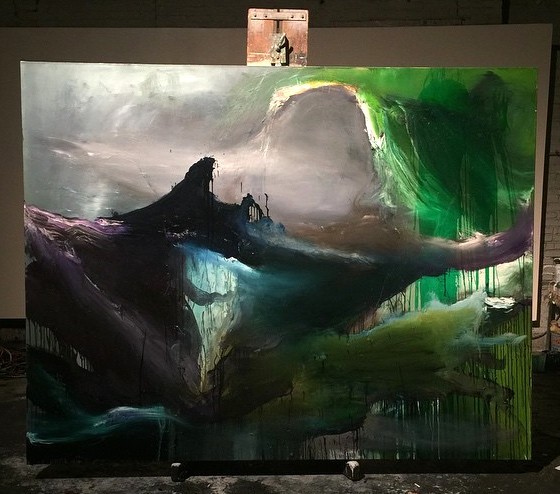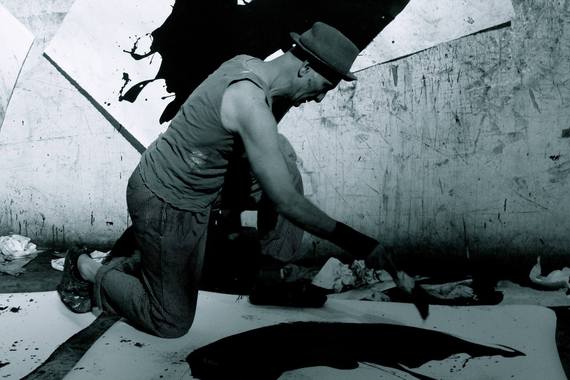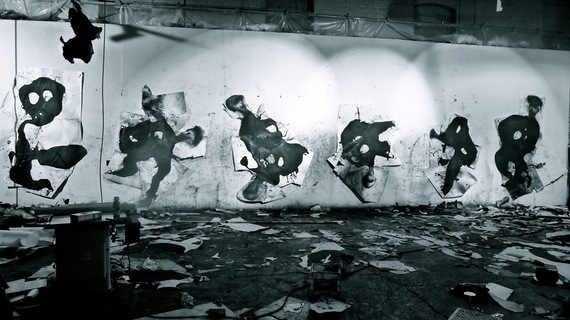I never see beauty. It is foreign to me and if even I could glimpse it, it would only be in recognition of a struggle gone cold, soon to be discarded as I move on. No satisfaction taken: a corpse kicked to the curb. It's about not knowing how to live, thats what painting is, what is performance, and coming with it, a whole lot of heartbreak. -- Wesley Kimler
Wesley Kimler's Chicago studio
Wesley Kimler, one of the last tough-guy painters, likes his studio chaotic. It's a kind of parallel universe, which suits Kimler fine, since he acknowledges that he has "an inability to live in the real world." Painting furiously, with some of his six exotic birds screeching as he works, Kimler is prone to 48 hour painting binges and also to re-working "finished" canvases. Kimler's most recent paintings have themes of war and he sees the creative process as a form of destruction. Still, he is clear about why he does what he does: "I make beautiful things for other people."
I recently interviewed Wesley Kimler and asked him to tell me a few stories, and share some of his opinions about art and artists.
Wesley Kimler: Photo by Amina Dollah Kimler
John Seed Interviews Wesley Kimler
JS: So, tell me about this tough childhood of yours...
WK: I left home at 14: I was on the run.
I was looking to get out of a bad situation at home and I just had to get away from where I was. As far as what I was looking for, I suppose I lacked intent -- it was kind of like being shot from gun -- I had run away so many times that when I finally got caught and went in front of a judge he said:
"Either you get into some kind of military boarding school or we are going to put you in one of our schools."
My hero at the time was the character Paul Newman played in Cool Hand Luke, so I said: "Yes sir, judge!" went home, found 22 dollars, got on a Greyhound bus and never went back. I grew up in the south of Market area of San Francisco, which at the time was a sizable area of downtown. It was a derelict district full of large dilapidated SRO hotels. I lived in them all at one point or another. I was a street kid.
Wesley Kimler: Photo by Amina Dollah Kimler
JS: How did you get through all this?
WK: One of the things that saved me and taught me how to survive is that I ended up being arrested with a small amount of pot, and even though I was underage I lied my way through two months of incarceration in San Francisco city and the county jail. My alias was "John Russell," from another Paul Newman film: Hombre.
Hey Hoooombre: you have put a hole in me!
I had to grow up pretty suddenly to survive that: afterwards the streets were a piece of cake. I was the prince of my domain, which consisted of all of south of Market between Third and Sixth Street. I remember stepping over the drunken winos, and being used to everything smelling of stale booze and vomit from one dusty hotel room to another as I could scrounge up the means. Of course, I was secure in knowing if I couldn't find some money on any given day, there was always Saint Anthony's Kitchen over in The Tenderloin district for stale donuts and watery beans.
Untitled
JS: So this all left you toughened up, and ready to move to Afghanistan, right?
WK: Well... yes! By the time I was 20 years old I was living in Afghanistan keeping apartments there in Kabul, Herat and Kandahar: I was working for an importer. I gotta say, it did get pretty out of control wild at times.
Afghanistan back then was like an eleventh century version of the Wild West. Living there was my real education -- my university you might say -- and graduating meant you didn't get yourself killed. I was still 20 (maybe 21) years old when I had to take a gun away from a man and kidnap him. I dragged his ass across Afghanistan and held him for ransom until he and his family coughed up the money they had stolen from the man I worked for. Just that one story is a would make a nice feature article someday for the Huffington Post...
The whole episode culminated on the dusty streets of Herat, Afghanistan, with me taking on this guy and his family and then the both of us being carted off to the Herat prison -- where fortunately the Turkish sergeant liked how kind of tough and hell or high-water I was -- and took up my cause. Abdul Awaz went to jail and I went free: a good thing as at that point they still had balls and chains for the prisoners.
Afghan Kite
JS: Wesley, I'm betting that a single article would barely scratch the surface. Give me one more good story and then we'll talk about art.
WK: I have always carried with me the images of my last afternoon in Afghanistan, as they reverberate and resonate through my life to this day. I was leaving with mixed emotions: I so loved the place and I had been there a long time. Anyways, I was traveling in the back of a lorry with 20-25 Pathans (Afghans) going through the gun turreted no-man's land lunar landscape of the Khyber Pass. It's a tribal area and you can only travel through there during the day.
Well, there was one Americanized lost soul of an Afghan who had been to a university here and of course he decided to adopt me as his ally/fellow sophisticate, in this truckload of illiterates. On and on he went about his backwards fellow countrymen: he was of course dressed in a suit, so proud of his university education. He didn't seem to get that I was dressed like everyone else in the truck that perhaps my sympathies were not 100% with him.
Anyways, we pulled up at the edge of a muddy gulch where a chai shop had been dug back into a cliff and I sat there and watched this man, child in his arms, black turban double rows of bullets crossing his chest, rifles slung on his back and then turned to his father -- his reverse image wearing a white turban -- and we spoke. I told them both how much I loved their country and how I had learned so much how much I didn't want to leave. Anyways, the old man got up, motioned to me C'mon and the three of us went in the back where there was a large hookah sitting there.
The black turbanned dude put some hashish in the pipe and his father admonished him: Don't be so cheap! Put a bigger chunk! Next, a hot coal was placed over the now larger chunk of hashish and we commenced smoking. It was strong, very strong, and I started coughing. At which point the Americanized Afghan burst into the room yelling: 'Mister, mister! don't do that ! It will make you crazy!
In response, the old man pointed to the door and replied:
"Burro baha'i! (Go by god!) This young man is more of an Afghan than you will ever be."
That remains, to this day the greatest compliment, I've ever received. It was the moment when I first considered the inherent dichotomy of the self-realized individual as opposed to the university driven generic.
Works on paper in progress
JS: As a university driven generic I need to think about that Wesley, but you tell a great story. Now tell me what happened next when you got back to the states.
WK: I started painting upon my returning from Afghanistan. I moved to Austin Texas where my formal studies began at Laguna Gloria School of Art. I painted with the little old ladies who were busy painting grandson Johnny or a niece and nephew's portrait. The little old ladies were for the most part badasses. I painted portraits, seascapes and still lifes. And yes, even then the comments were always along the lines of: "There is something different about your work Wesley. You are going to go do something larger than this place."
Funny enough when I went to a regular art school (MCAD) everyone was like WHERE did you learn to paint like that? With the little old ladies is where...
Untitled (Seascape)
JS: How did you get your nickname: "The Shark"?
WK: You bring up my old alter ego 'The Shark,' which I employed while being the leader/mascot /driving force behind Shark Forum blogsite here in Chicago. Shark Forum served multiple purposes: first it was a weapon I used to attack institutional hackademic art world apparatchiks that run rough roughshod over the Chicago scene emanating from the art education system. Primarily at this point in time, SAIC. The Shark, swam in a cesspool of institutionalized corruption pushing academic conformity/ mediocrity.
War, Kite Flyers: for Shannon, 2015, 9 x18 feet, alkyd resin on canvas
JS: So you have some pretty stinging things to say about the Chicago art scene...
WK: Of course Chicago can surely be seen as metaphor for the toweringly stupid art world of the moment. Its such a sea of shit awash in massive piles of stupid money: where to begin taking on this dystopia?
Wesley Kimler: Photo by Amina Dollah Kimler
JS: What about New York?
WK: Look at The Forever Now exhibition now on view at MOMA in New York: not a good painter in sight. Much has been written about how bad it is. As Christian Viveros-Faune noted, it should be called Forever Sucks. But then, everyone is using the pejorative term Walter Robinson coined -- Zombie Formalism -- which is great.
In NYC we are looking at massive decline and a whole power structure in place: holding the reins, clinging to power. As far as critics go, I like Jerry Saltz quite a lot. He is a good man and in ways the equivalent H.L. Mencken of today's art world. That doesn't mean he knows anything about painting. I am convinced actually, that he wouldn't know a good painting if it came up and bit him on the ass. The problem is that he's not alone!
Operation: Foragers (Admiral Raymond Spruance), 2015
12 x9 feet, alkyd resin on canvas
JS: Who are your artist heroes?
WK: As a kid I would wander through the old Museum of Modern Art in San Francisco and scratch my head at those strange David Park paintings. Even after a few years of art school I was far more interested in the Bay Area Funk scene -- Roy De Forrest with his psychedelic dogs -- and then I changed and started seeing the way I see even now. I love early Joan Brown and her work became very important to me: also Diebenkorn, early Paul Wonner and Frank Lobdell. But first and foremost is David Park.
I like a wide range of painting going back in history: what serious painter doesn't? Titian was good...
I think we can ixnay the lower strata of Impressionism and revisit Gerome and Messionier: some revisionism might be in order there. Malcolm Morley I have always liked the whole London school: particularly Kossoff. My friend Don Suggs is a brilliant painter as is another pal Ashley Bickerton.
Mark Dutcher and I have become fast friends: he is a wonderful painter who is just now unfolding. Ed Moses is a dear friend and hero of mine for sure both as a painter and as a man. And of course Joan Mitchell and de Kooning are important to me, but so is Lee Bontecou.
The Norwegian artist Bjarne Melgaard is doing interesting work.
The drawing wall in Wesley Kimler's studio
JS: What would you say is the situation of painting right now?
WK: There are all kinds of art and all kinds of painting. No matter your preference, there are good versions and bad versions. The trouble is that in this age of visual illiteracy, the people in power are clueless as to the difference.

